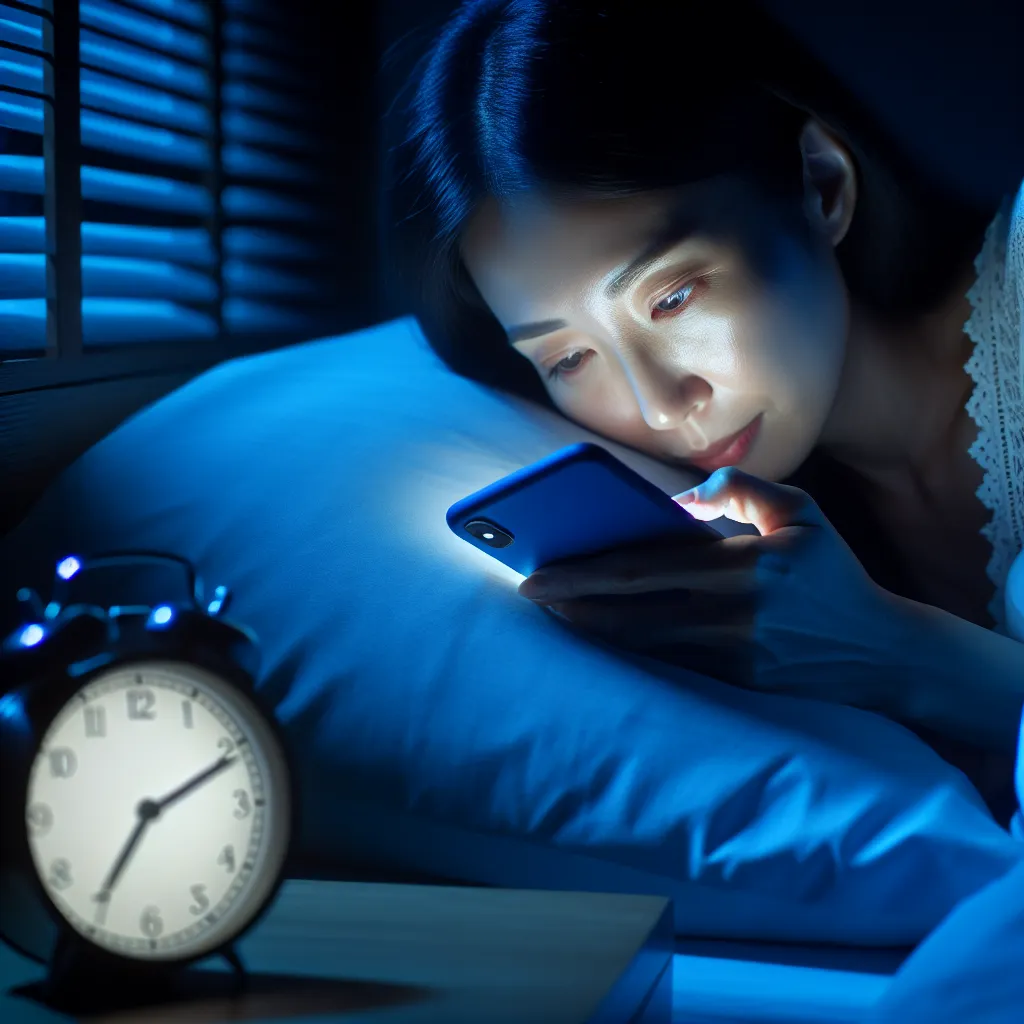The IELTS Reading section is a crucial component of the test, assessing your ability to comprehend complex texts and extract specific information. Today, we’ll focus on a topic that has become increasingly relevant in our digital age: “The Effects of Technology on Sleep Patterns.” This subject has appeared frequently in recent IELTS exams, reflecting its growing importance in modern society. Given its relevance and the ongoing technological advancements, it’s highly likely that similar themes will continue to feature in future IELTS Reading tests.
 Technology affecting sleep patterns
Technology affecting sleep patterns
IELTS Reading Practice Test
Reading Passage
The Impact of Technology on Our Sleep
In the digital age, our lives are increasingly intertwined with technology. From smartphones to laptops, and from social media to streaming services, we are constantly connected to the digital world. While these technological advancements have brought numerous benefits, they have also had a significant impact on one of the most fundamental aspects of human health: our sleep patterns.
Recent studies have shown that the use of electronic devices before bedtime can have detrimental effects on both the quantity and quality of our sleep. The blue light emitted by screens on devices such as smartphones, tablets, and computers can disrupt our body’s natural circadian rhythm. This rhythm, also known as our “body clock,” regulates our sleep-wake cycle and is influenced by light exposure. The blue light from screens mimics daylight, tricking our brains into thinking it’s still daytime, thereby suppressing the production of melatonin, the hormone responsible for inducing sleep.
Moreover, the content we consume through these devices can also affect our sleep. Engaging with work emails, scrolling through social media, or watching stimulating videos can increase cognitive arousal, making it harder to wind down and fall asleep. The constant notifications and the fear of missing out (FOMO) can lead to what researchers call “bedtime procrastination,” where individuals delay sleep despite being tired.
However, it’s not all doom and gloom. Technology, when used mindfully, can also be harnessed to improve our sleep. Sleep-tracking apps and wearable devices can provide valuable insights into our sleep patterns, helping us identify areas for improvement. Some devices offer features like blue light filters or nighttime modes that reduce the harmful effects of screen light in the evening.
Experts recommend establishing a “digital curfew” – a set time each night when all electronic devices are turned off or put away. This allows the body to naturally prepare for sleep without the interference of artificial light and stimulating content. Creating a relaxing bedtime routine that doesn’t involve screens, such as reading a physical book or practicing meditation, can also significantly improve sleep quality.
As we continue to navigate the digital landscape, it’s crucial to find a balance between leveraging the benefits of technology and protecting our sleep health. By being aware of the effects of technology on our sleep patterns and making conscious choices about our device usage, we can ensure that our technological habits support, rather than hinder, our overall well-being.
Questions
1-5: Choose the correct letter, A, B, C, or D.
-
According to the passage, what is the primary way technology affects our sleep?
A) By making us more productive during the day
B) By disrupting our natural circadian rhythm
C) By improving the quality of our mattresses
D) By reducing the need for sleep -
What does the blue light from electronic devices do?
A) It helps us fall asleep faster
B) It increases melatonin production
C) It mimics daylight and suppresses melatonin
D) It has no effect on our sleep patterns -
What is “bedtime procrastination”?
A) Sleeping later than usual
B) Delaying sleep despite feeling tired
C) Procrastinating work tasks before bed
D) Setting multiple alarms in the morning -
How can technology be used positively for sleep, according to the passage?
A) By providing entertainment before bed
B) By offering insights through sleep-tracking apps
C) By replacing traditional alarm clocks
D) By eliminating the need for a bedtime routine -
What is a “digital curfew”?
A) A time limit for using social media
B) A set time to turn off or put away electronic devices
C) A government-imposed restriction on internet usage
D) A feature that automatically turns off devices
6-10: Complete the sentences below.
Choose NO MORE THAN TWO WORDS from the passage for each answer.
-
The body’s natural sleep-wake cycle is regulated by the _____.
-
Engaging with work emails or social media before bed can increase _____, making it harder to fall asleep.
-
Some devices offer _____ that reduce the harmful effects of screen light in the evening.
-
Experts suggest creating a relaxing bedtime routine that doesn’t involve _____.
-
By being aware of technology’s effects on sleep and making conscious choices, we can support our overall _____.
Answer Key
- B
- C
- B
- B
- B
- circadian rhythm
- cognitive arousal
- blue light filters
- screens
- well-being
Explanations
-
B is correct. The passage states that technology, particularly the blue light from screens, disrupts our natural circadian rhythm.
-
C is the right answer. The text explicitly mentions that blue light mimics daylight and suppresses melatonin production.
-
B is correct. The passage defines “bedtime procrastination” as delaying sleep despite being tired.
-
B is the correct answer. The passage mentions that sleep-tracking apps can provide insights into our sleep patterns.
-
B is the right choice. The text defines a “digital curfew” as a set time to turn off or put away electronic devices.
-
The correct answer is “circadian rhythm.” The passage states that this regulates our sleep-wake cycle.
-
“Cognitive arousal” is the correct answer. The text mentions that engaging with emails or social media can increase this, making it harder to sleep.
-
“Blue light filters” is correct. The passage mentions these as features that can reduce harmful effects of screen light.
-
“Screens” is the right answer. The text suggests creating a bedtime routine without screens.
-
“Well-being” is the correct answer. The passage concludes by saying that conscious choices about technology use can support our overall well-being.
Common Mistakes
When tackling IELTS Reading questions on topics like technology and sleep patterns, test-takers often make the following mistakes:
-
Misinterpreting cause and effect: Be careful to distinguish between the effects of technology on sleep and the ways technology can be used to improve sleep.
-
Overlooking specific details: Pay close attention to precise terms like “circadian rhythm” and “cognitive arousal.”
-
Falling for distractors: In multiple-choice questions, some options may seem plausible but aren’t supported by the text. Always refer back to the passage.
-
Exceeding word limits: In sentence completion tasks, stick strictly to the word limit given.
-
Incorrect spelling: Even if your answer is conceptually correct, spelling errors will result in a loss of marks.
Vocabulary Focus
Here are some key vocabulary items from the passage, along with their definitions and pronunciations:
- Circadian rhythm (n.) /sərˈkeɪdiən ˈrɪðəm/ – the natural, internal process that regulates the sleep-wake cycle
- Melatonin (n.) /ˌmeləˈtoʊnɪn/ – a hormone that regulates sleep cycles
- Cognitive arousal (n.) /ˈkɒɡnətɪv əˈraʊzl/ – mental stimulation that increases alertness
- Procrastination (n.) /prəˌkræstɪˈneɪʃn/ – the action of delaying or postponing something
- Detrimental (adj.) /ˌdetrɪˈmentl/ – tending to cause harm
Grammar Spotlight
Pay attention to the use of conditional sentences in the passage:
“Technology, when used mindfully, can also be harnessed to improve our sleep.”
This is an example of a first conditional sentence, used to talk about a real possibility in the present or future. The structure is:
If/When + present simple, will/can + infinitive
Practice using this structure to discuss other potential effects of technology on daily life.
Tips for IELTS Reading Success
-
Time management is crucial. Spend about 20 minutes on each passage in the Reading test.
-
Skim the questions before reading the passage to know what information to look for.
-
Don’t spend too much time on one question. If you’re stuck, move on and come back later if time allows.
-
Practice reading a variety of texts on different topics to build your vocabulary and comprehension skills.
-
Remember that the answers will appear in the same order as the information in the passage.
-
For sentence completion tasks, pay attention to grammar. The completed sentence should be grammatically correct.
By following these tips and regularly practicing with passages like “The Effects of Technology on Sleep Patterns,” you’ll be well-prepared for the IELTS Reading test. Remember, consistent practice is key to improving your reading speed and accuracy.
For more IELTS preparation resources, you might find our articles on the effects of digital addiction on mental health and the effects of technological advancements on healthcare delivery helpful in broadening your understanding of technology-related topics that may appear in the IELTS test.


